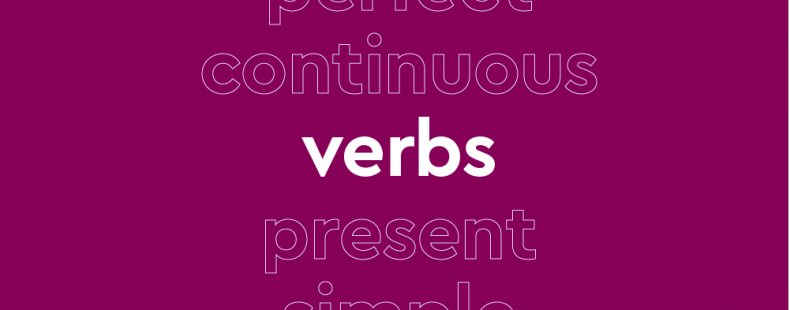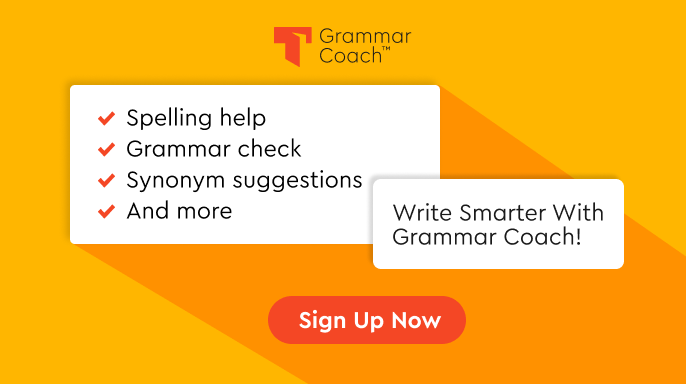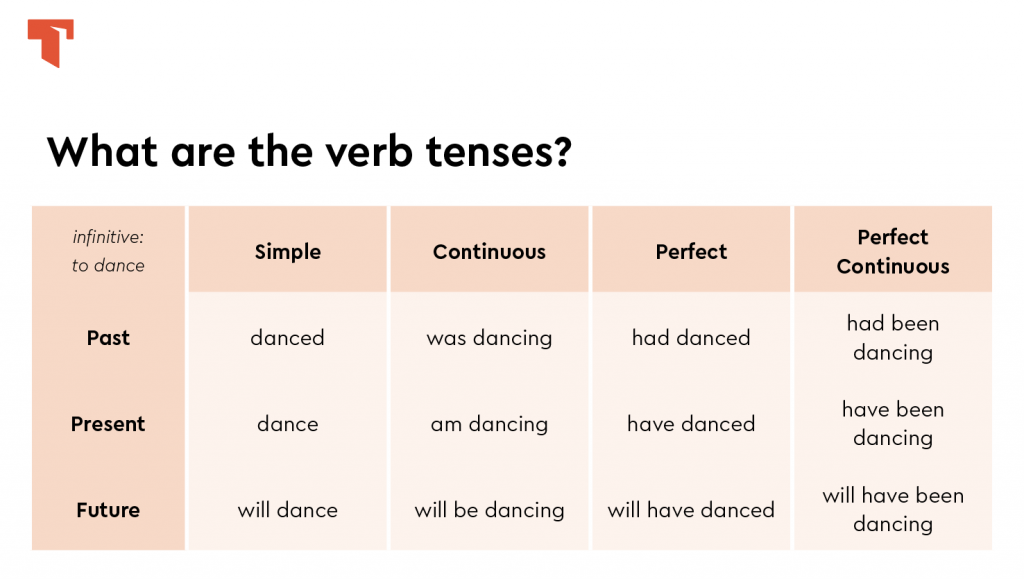If you’re familiar with basic English grammar, we bet you can describe a verb and perhaps name a tense or two. In the sentences the boy walks and the girl ran, the words walks and ran are the verbs.
Did you also recognize that walks is in the present tense, or that ran is in the past tense? Whether you did or didn’t, we’re here to review verb tenses with you and also astound you with the fact that there are 12—count them, 12—verb tenses in all!
What is a verb tense?
Generally speaking, verb tenses identify the time period when an action occurs. The verb walks communicates not only how many people completed the action (it’s singular), but also when it occurred. In this case, the tense is present. The person walks right now.
Interestingly, not all languages treat verb tenses the same way. In English, the ending on a verb communicates what tense it’s in. (Walk becomes walks and walked.) In some cases, an auxiliary verb (also known as a helping verb, like will or need) is required as well. In Chinese languages, for example, a verb doesn’t change its spelling depending on the tense. A separate word (or particle) is combined with the verb to explain when it occurred.
12 types of verb tenses
The simple tenses (past, present, and future) are the most basic forms, but there are 12 major verb tenses in English in all. We’ll review the tenses here.
Past tenses
The past tenses use verbs to say that something happened in the past, meaning any time before this moment right now. There are four variations of past tenses:
- Simple past: describes events that began and ended in the past.
- Past continuous: describes events that began in the past, continued for a length of time, and ended in the past.
- Past perfect: describes a past event that occurred before another past event.
- Past perfect continuous: describes an event that began in the past, continued for a length of time, and was in progress when another past event happened.
Simple past
The simple past tense describes events that have already happened and are completely finished. Most verbs can be made past tense by adding -ed, –d, or sometimes the variant –t at the end of a present tense verb, as in liked and watched.
However, many irregular verbs have unique past tense forms. For example, go becomes went, and think becomes thought.
Simple past is usually used to write about historical events, like so:
- Galileo observed the stars.
In this example, the verb tense indicates that the astronomer Galileo completely finished the act of observing the stars at some point in the past.
Past continuous
The past continuous tense describes an ongoing activity that occurred in the past. It is formed by combining the past tense verb to be (which must be correctly conjugated to agree with the subject) and the present participle of a verb (ending in –ing):
- The planet was moving along an elliptical orbit.
In this example, the verb tense says that the planet began moving sometime in the past and continued to do so for a period of time (in the past).
Establish the different times to use was vs. were so you won’t have any mistakes again.
Past perfect
The perfect tenses involve more complex time relationships. They build upon simple tenses by combining a verb with has, have, or had.
The past perfect tense, also called the pluperfect tense, describes a past event in relation to another event that occurs closer to the present. It is formed by combining had and the past participle of the verb.
- The girl bought the telescope her teacher had recommended to her.
The girl bought (simple past) what the teacher had recommended (past perfect tense). One action occurred (had recommended) before the other (bought).
Past perfect continuous
The past perfect continuous tense describes an ongoing action that—like the past perfect—was performed in relation to another event that occurs closer to the present. It is formed by combining had been with the present participle of the verb.
- He had been studying for his astronomy final when the doorbell rang.
The above example uses the verb tense to indicate that he was studying for a length of time before another event (the doorbell ringing) interrupted or stopped his act of studying.
Present tenses
Generally speaking, we use the present tenses to say that an event is happening right now in the present time. Like the past tenses, there are four variations of present tenses:
- Simple present: Describes an event as happening in the present.
- Present continuous: Describes an event as being in progress in the present and likely continuing into the future.
- Present perfect: Describes an event that occurred in the past but has some connection to the present.
- Present perfect continuous: Describes an event that began in the past but still continues to happen in the present.
Simple present
The simple present tense describes events happening now. It’s also useful for describing a direct action that’s not exclusive to the past or future.
Sentences in present tense often have the most straightforward structure because they use the root form of the verb or a conjugation of the verb to be. The root form of the verb is the form you will find if you look up a verb in our dictionary.
We often use the simple present tense to state facts:
- Cats eat mice and birds.
In this sentence, the simple present tense is used to state the fact that cats regularly eat mice and birds.
When you use the verb be in the simple present tense, it must agree with the subject of the sentence. For example:
- I am tall.
- You are my best friend.
- She is my older sister.
- We are hungry.
- They are late for work.
Present continuous
The present continuous tense describes an ongoing activity that is happening now, in the present. It is formed by combining the verb to be and the present participle of the verb (ending in –ing):
- The baby is laughing at Shelly’s monkey puppet.
In this example, the verb tense is used to state that the baby is currently in the process of laughing at Shelly’s silly puppet and will likely continue to do so for a while yet.
Present perfect
The present perfect tense describes a past event that’s still happening in the present. It is formed by combining the word has or have (depending on the subject) with the past participle of the verb.
Let’s look at this sentence:
- The baby has played this game before.
In this example, the verb tense states that a past event is related to the present. In this case, the sentence is saying that the baby is currently playing a game that they have also played at another time in the past.
Present perfect continuous
The present perfect continuous tense describes an ongoing action that began in the past and is still occurring in the present. It is formed by combining the phrase has been or have been (depending on the subject) with the present participle of the verb.
- Shelly has been babysitting for years.
In this example, the verb tense is used to say that Shelly started babysitting children in the past, continued to babysit for years, and still continues to babysit now.
Future tenses
We use the future tenses to say that an event will happen sometime in the future. Like past and present tenses, there are four variations of future tenses:
- Simple future: Describes an event that will begin and end in the future.
- Future continuous: Describes an event that will begin in the future and continue for a length of time.
- Future perfect: Describes a future event that will happen before another future event.
- Future perfect continuous: Describes a future event that will begin, continue for a length of time, and still be in progress when another future event occurs.
Simple future
The simple future tense describes events that haven’t happened yet. It’s useful for describing an intended action or a prediction. It’s typically formed by combining the word will or, less commonly, shall with a root verb.
For example:
- Molly will finish her chores when she has time.
- We shall travel to France next summer.
The word will is an auxiliary verb, and finish is the root verb. Together, they explain that Molly intends to do her chores at a later point in time.
Learn more about auxiliary verbs and the verbs they help out, here.
Future continuous tense
The future continuous tense describes an activity that will extend over a period of time and will happen in the future. It is formed by combining the phrase will be and the present participle of the verb (ending in –ing):
- I will be working all afternoon, so I can’t help Olivia with her report.
In this sentence, the verb tense is used to say that I plan to work for a period of time in the future.
Future perfect tense
The future perfect tense describes an upcoming action in relation to another event farther in the future. It is formed by combining the phrase will have and the past participle of the verb:
- By tomorrow afternoon, Olivia will have finished her report.
This sentence uses the future perfect tense to say that Olivia’s report is incomplete right now, but it will be finished before tomorrow afternoon.
Future perfect continuous
The future perfect continuous tense describes an action that will extend over a period of time and will be performed in relation to another future event. It is formed by combining the phrase will have been with the present participle of the verb (ending in –ing):
- When this show ends, Molly will have been watching TV for three hours.
This sentence uses the future perfect continuous tense to say that, in the future, Molly will be watching TV for three hours when this show ends (which will also happen in the future). By using the future perfect continuous tense, this sentence also implies that Molly may still continue to watch TV even after the show is over.
Perfect grammar has never been easier
To avoid confusion, you should use one consistent tense whenever possible.
❌ Incorrect: The crowd claps and laughed at the comedian.
✅ Correct: The crowd clapped and laughed at the comedian.
The incorrect example contains both a present tense verb (claps) and a past tense verb (laughed). This can be confusing. If both actions are past or present, both verbs should have the same tense.
One final tip: you won’t mistake your verb tenses when you check your writing on Thesaurus.com’s Grammar Coach™. This writing tool uses machine learning technology uniquely designed to catch grammar and spelling errors. Its Synonym Swap will find the best nouns, adjectives, and more to help say what you really mean, guiding you toward clearer, stronger, writing.
















